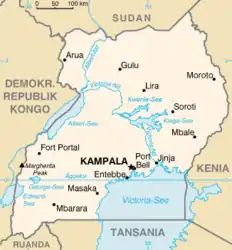Kupsabiny language
Kupsabiny (Sabiny), or Sebei, is a Kalenjin language of eastern Uganda.
| Kupsabiny | |
|---|---|
| Sabiny | |
 Uganda, where Kupsabiny is spoken | |
| Native to | Uganda |
| Ethnicity | Sebei |
Native speakers | 181,000 (2002 census) |
| Latin script | |
| Language codes | |
| ISO 639-3 | kpz |
| Glottolog | kups1238 |
Classification
Kupsabiny and a dozen other languages form the Southern Nilotic branch of the Nilotic family. The closest relative of Kupsabiny is Sabaot, spoken across the border in Kenya.[1]
Speakers
There are about 180,000 people in the world who currently speak the language, most of them being native speakers of it. The number of speakers is currently growing and the language is considered developing.[2] Although the language is spoken primarily by Sebei people, it is taught in many primary schools and even beyond to boost communication levels.
Language
The language of Kupsabiny is solely spoken in Uganda. The native speakers of the language are the Sebei people, an ethnic group who live in Uganda. Kupsabiny is a Nilotic language; along with many other languages of the Nilotic peoples. The language is highly tonal. There are 9 vowels and 14 consonants. The language is written with Latin script since 1975 (revised in 2010). Kupsabiny is taught in primary schools and is backed by literacy campaigns to help aid with communication across Uganda.[3]
Phonology
13 consonants are in Sebei (Kupsabiny):
| Labial | Alveolar | Palatal | Velar | |
|---|---|---|---|---|
| Stop | p | t | c | k |
| Fricative | s | |||
| Nasal | m | n | ɲ | ŋ |
| Lateral | l | |||
| Rhotic | ɾ | |||
| Approximant | w | j |
There are a variety of consonant allophones in Sebei (Kupsabiny):
| Labial | Alveolar | Palatal/ Postalveolar |
Velar | ||
|---|---|---|---|---|---|
| Stop | voiceless | p, [b] | t, [tʰ, d] | c, [tʃ, tʃʼ, dʒ] | k, [kʰ, ɡ] |
| voiced | |||||
| Fricative | voiceless | s, [ʃ, z] | |||
| voiced | |||||
| Nasal | m | n | ɲ | ŋ | |
| Lateral | l | ||||
| Rhotic | ɾ, [r] | ||||
| Approximant | w | j | |||
Sebei (Kupsabiny) has 6 vowels:
| Front | Central | Back | |
|---|---|---|---|
| High | i | u | |
| Mid | e | o | |
| ɔ | |||
| Low | a |
Vowels with short and long vowel allophones listed in brackets are below:
| Front | Central | Back | ||
|---|---|---|---|---|
| High | i | u | ||
| [ɪ] | [ʊ] | |||
| Mid | e | [ɤ] | o | |
| [ɛ] | [ʌ] | ɔ | ||
| Low | [æ] | |||
| a | [ä] | |||
Tone is marked as high, mid, or low.[4]
References
- Distefano, John Albert (1985). The precolonial history of the Kalenjin of Kenya: a methodological comparison of linguistic and oral traditional evidence.
- "Where on earth do they speak Kupsabiny?". www.verbix.com. Retrieved 2016-10-25.
- "Kupsapiiny". Ethnologue. Retrieved 2016-10-25.
- O'Brien, Richard; Cuypers, Wim A.M. (1975). A descriptive sketch of the grammar of Sebei. Washington, D. C.: Georgetown University Press.
